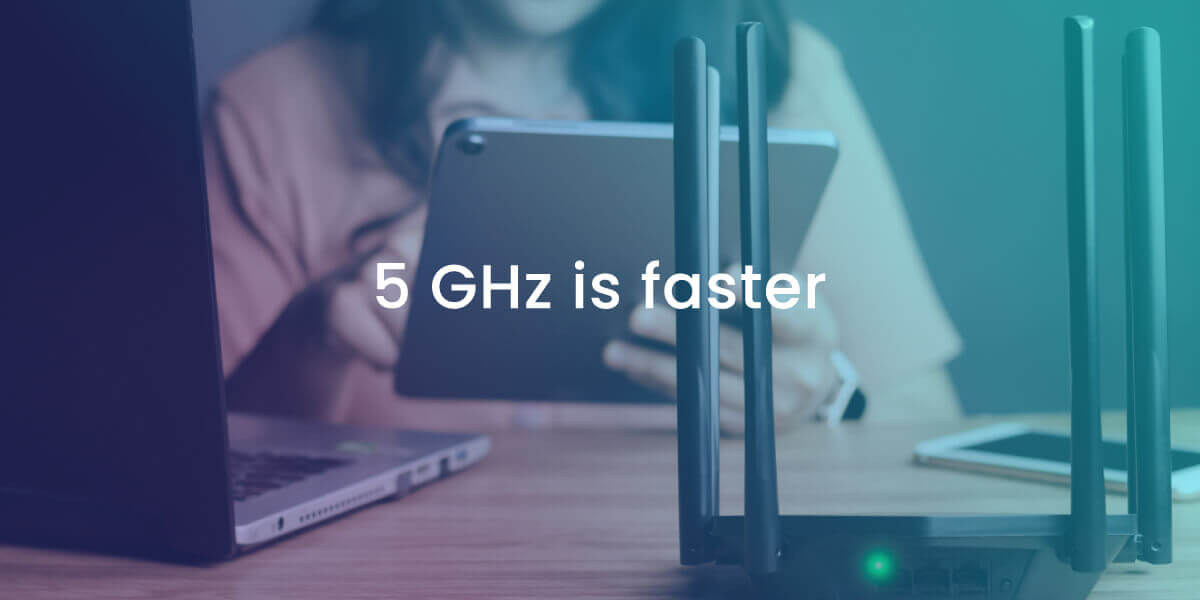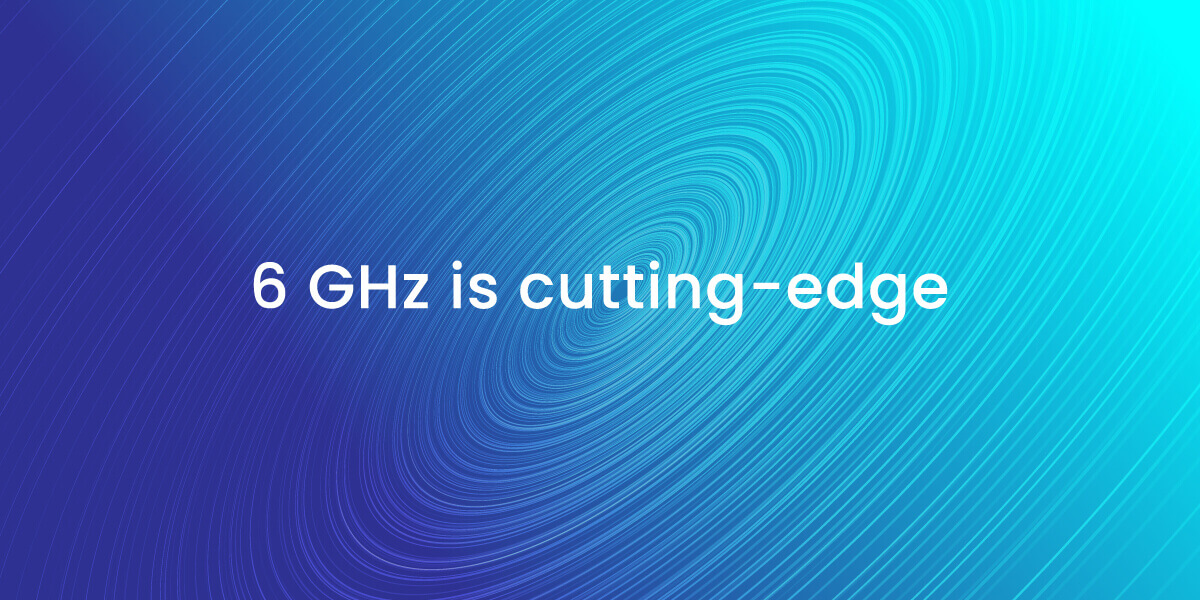2.4 GHz vs. 5 GHz: Choosing Your Best Wi-Fi Frequency

Table of Contents
Do you have the right Wi-Fi setup to give you your fastest, smoothest internet connection?
Maybe you’ve heard words like “frequency” and “router channels” tossed around without knowing why they matter. In this article, you can learn why you might want to change your Wi-Fi frequency.
The two most common frequencies are 2.4 GHz and 5 GHz. You’ll get different benefits from each frequency depending on how big your home is, how it’s laid out, and whether you have many people living nearby.
What’s the difference between Wi-Fi frequency and Wi-Fi channels?
Wi-Fi works using radio waves to send your internet signals through the air so there’s no need for wires or cables.
“Frequency” describes the wavelength of those radio waves.
“Channels” are smaller divisions within a frequency. So, you can have many channels in one frequency. You can change your Wi-Fi router channels without changing your frequency.
What are the different Wi-Fi frequencies?
Wi-Fi comes in three main frequencies: 2.4 GHz, 5 GHz, and 6 GHz.
GHz means “gigahertz” and is the unit we use to describe wavelength.
The 6 GHz frequency became available to the public much more recently than the other two and is only available with Wi-Fi 6E technology.
Because Wi-Fi 6E is not yet common, we’re going to focus on the two most common frequency bands, 2.4 GHz vs. 5 GHz.
These two frequencies have different strengths and weaknesses, and the frequency you choose will affect your home Wi-Fi’s performance. Here’s a table of the official standard numbers that support the 2.4 and 5 GHz frequencies.

Introducing 2.4 GHz Wi-Fi
The 2.4 GHz frequency has been around for home internet since the early 1990s. Your Wi-Fi on 2.4 GHz will have good range, and it will do a good job transmitting signals through walls and ceilings.
Benefits of 2.4 GHz Wi-Fi
If you live in a large household or even a small home with lots of internal walls or several floors, you may want to use 2.4 GHz. The 2.4 GHz frequency can cover a larger area and penetrate solid objects better than 5 GHz Wi-Fi. As the oldest frequency, 2.4 GHz is also compatible with almost all Wi-Fi devices, including older models.
Drawbacks of 2.4 GHz Wi-Fi
The 2.4 GHz frequency has weaknesses too. Your Wi-Fi speed will be slower on 2.4 GHz than on the 5 GHz frequency. Plus, 2.4 GHz has many more users than any of the other frequencies. Those users can make the 2.4 frequency band congested. When a bunch of users crowd onto the 2.4 GHz frequency, as in a city or in an apartment complex, you may get interference and slower network performance.

Exploring 5 GHz Wi-Fi
The 5 GHz frequency is a newer technology that became common in the early 2000s. The 5 GHz frequency delivers data at a higher speed, but it doesn’t have as far-reaching coverage and its signals have a harder time penetrating physical obstacles.
Benefits of 5 GHz Wi-Fi
5 GHz Wi-Fi can handle more data at once than 2.4 GHz Wi-Fi. You’ll appreciate this if you’re gaming or streaming in HD. Plus, a Wi-Fi network on 5 GHz will get less interference because there are not as many devices operating at this frequency.
Drawbacks of 5 GHz Wi-Fi
The problem you may run into with 5 GHz Wi-Fi is its shorter range compared to 2.4 GHz. If your device is set up far away from the router, you may get slow speeds or dropped signals. Also, be aware that some older devices won’t be able to support 5 GHz signals.
Switching to 5 GHz Wi-Fi
If you want to shift to 5 GHz Wi-Fi, you’ll need a router that supports it. You can check for these specs in the router’s manual or packaging. Once you have the appropriate router, you can set up a distinct 5 GHz network in your Wi-Fi settings. Some newer routers will automatically optimize your frequencies and channels for you, but you can choose router settings manually too.
Getting the Best of Both Frequencies
Can’t decide between the two frequencies? You can use both if you have a dual-band or tri-band router. These two or three-band devices will let you choose the best frequency for each device and situation. Many of them will even automatically optimize it for you.

What if I want 6 GHz? Wi-Fi 6 vs. Wi-Fi 6E
It can be confusing trying to figure out all the numbers that go with Wi-Fi frequencies, so here’s one key difference to remember. Wi-Fi 6 is the technology that brought us the 5 GHz frequency for our use with home Wi-Fi networks.
That’s right: Wi-Fi SIX (6) goes with FIVE (5) GHz. They didn’t want to make it too easy for you to match up these numbers.
Only by adding one little letter to Wi-Fi 6E do you get the 6GHz frequency. So, if you really want the latest tech, you have to remember the difference between Wi-Fi 6 and Wi-Fi 6E.
Wi-Fi 6e is the first standard to work on the 6 GHz frequency. It offers even faster speeds and more bandwidth than 5 GHz. You’ll also see even less congestion on the 6GHz frequency. Wi-Fi 6E is becoming more common in new devices every year. If you want to use it, make sure all your devices are equipped to support Wi-Fi 6E. Both your router and your tablet/computer would need to support Wi-Fi 6E for you to be able to use 6GHz.
Choosing your Best Wi-Fi Frequency
Let’s sum up the main things you need to consider before you choose between 2.4 GHz and 5 GHz. (Or maybe even 6 GHz, if you’re an early adopter!)
- Household area, or the distance your Wi-Fi signal will have to cover to reach the whole home
- Home layout, especially how many walls and floors lie between your router and your devices
- Neighbors near you, which will determine how much congestion you’ll get on 2.4 GHz
Now that you know, you’re on your way to the best internet performance you can get from your Wi-Fi!












 Call
Call 

 Access Your Account
Access Your Account